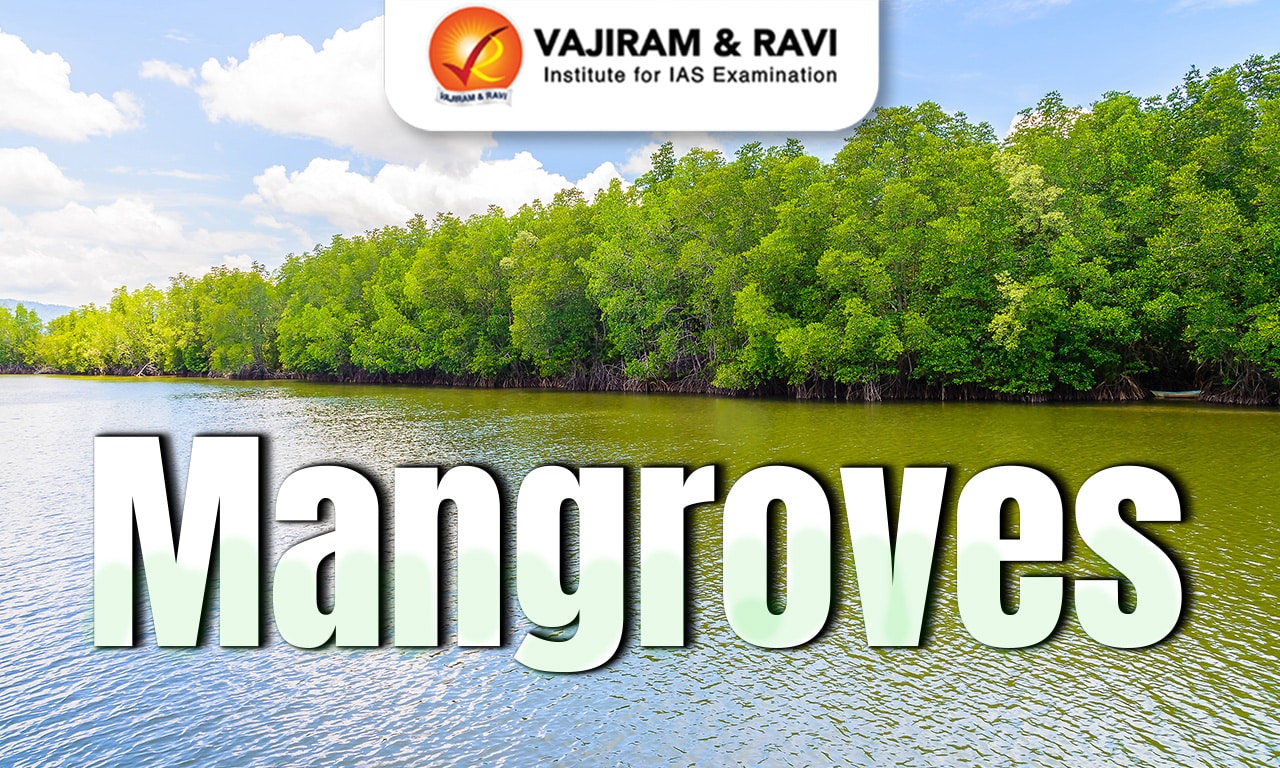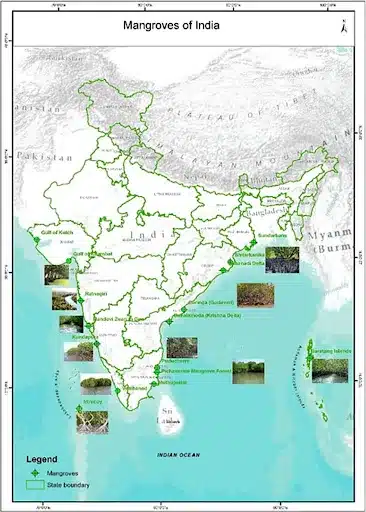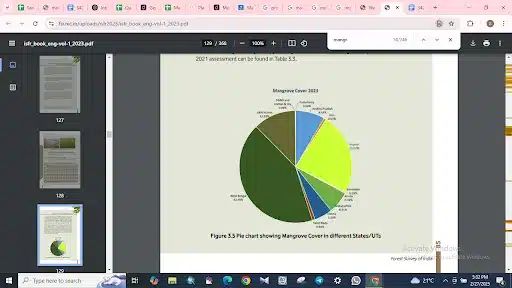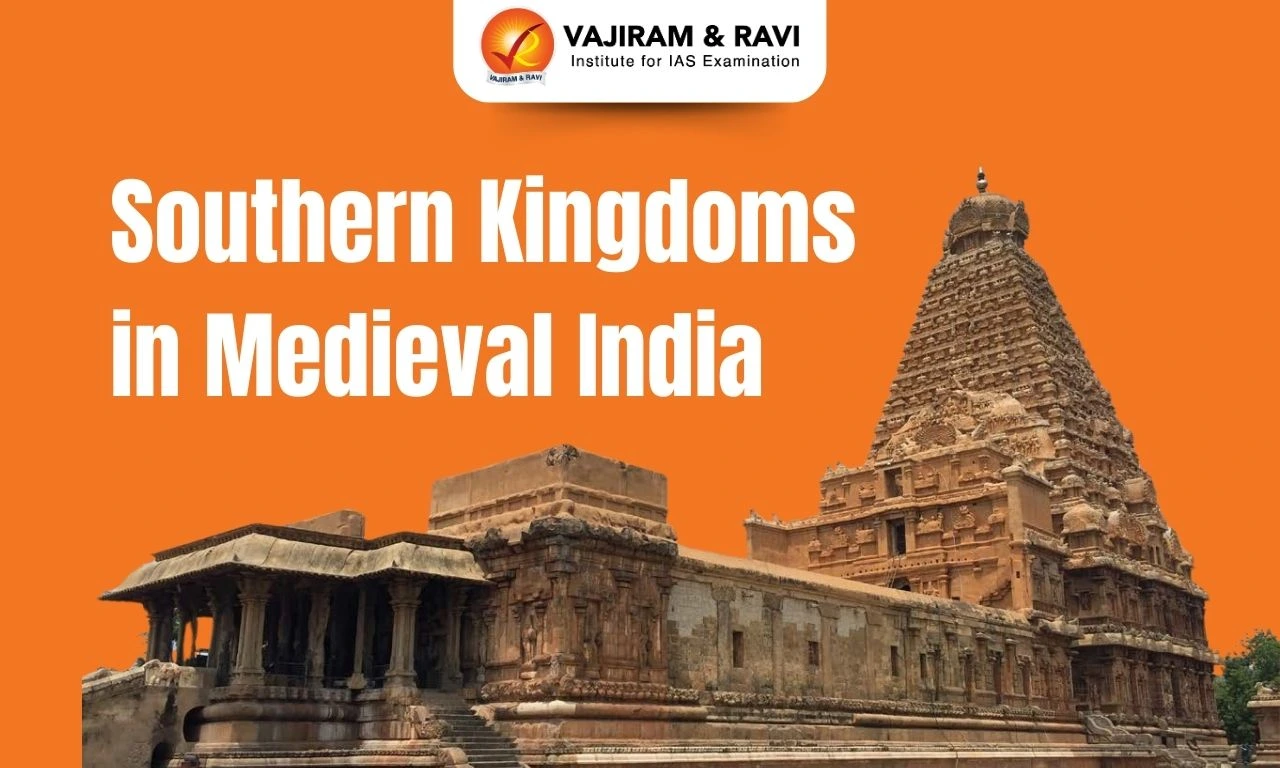Mangroves are salt-tolerant trees that thrive in coastal intertidal zones, acting as natural buffers against erosion, storing carbon, and supporting biodiversity. India hosts significant mangrove forests, with the Sundarbans being the largest. However, these ecosystems face threats from cyclones, rising sea levels, deforestation, pollution, and rapid urbanisation, leading to habitat degradation and loss.
To protect mangroves, global initiatives like the Ramsar Convention and national programs such as MISHTI and CRZ regulations have been implemented. Moving forward, raising awareness, restoring degraded areas, investing in research, and encouraging community participation are essential for their conservation and sustainable management.
Mangroves Definition
Mangroves are salt-tolerant trees and shrubs that grow in coastal intertidal zones, primarily in tropical and subtropical regions. These unique ecosystems thrive in saline or brackish waters, withstanding harsh environmental conditions such as tidal fluctuations, high salinity, and low oxygen levels in the soil. Mangrove forests act as a crucial buffer between land and sea, providing habitat for various marine and terrestrial species.
Mangroves Characteristics
Mangroves are uniquely adapted to thrive in coastal ecosystems through features like salt tolerance, aerial roots for respiration, and vivipary for seed germination in saline conditions. These adaptations not only help them survive harsh environments but also contribute significantly to carbon sequestration, playing a vital role in climate change mitigation.
- Salt Tolerance: They possess specialised root structures, such as salt-filtering roots and salt-excreting leaves, to manage high salinity levels.
- Aerial Roots (Pneumatophores): These roots help in respiration by obtaining oxygen from the air in waterlogged soils.
- Prop Roots: Provide stability against tidal waves and storm surges.
- Vivipary (Seed Germination): Seeds germinate while still attached to the parent tree to overcome the challenge of germination in saline water.
- Efficient Carbon Sequestration: Mangroves are among the most carbon-rich ecosystems, playing a vital role in mitigating climate change.
Mangroves Forest in India
India is home to extensive mangrove forests, primarily along its eastern and western coasts and island territories. Some of the prominent mangrove ecosystems in India's environment include:
- Sundarbans (West Bengal): The largest mangrove forest in the world, home to the Royal Bengal Tiger.
- Mahanadi, Godavari, and Krishna Deltas (Odisha & Andhra Pradesh): Rich in biodiversity and crucial for coastal protection.
- Pichavaram Mangroves (Tamil Nadu): One of the largest mangrove complexes in India.
- Bhitarkanika Mangroves (Odisha): A Ramsar site known for estuarine crocodiles.
- Gulf of Kutch (Gujarat): A unique ecosystem in an arid region.
- Andaman & Nicobar Islands and Lakshadweep: Important mangrove habitats providing shelter to diverse marine life.
Mangroves Status in India
India has taken significant steps to protect and conserve its mangrove ecosystems. According to the India State of Forest Report (ISFR) 2023, the mangrove status in India is as follows.
- The total mangrove cover in India is 4,992 sq. km, which is 0.15% of India’s total geographical area.
- West Bengal has the largest mangrove cover (42.45%), followed by Gujarat (23.66%) and Andaman & Nicobar Islands (12.39%).
- The largest mangrove forest in India is the Sundarbans in West Bengal, which is also considered one of the largest mangrove ecosystems globally.
Mangroves Importance
Mangroves provide numerous ecological, economic, and climate-related benefits. They act as coastal protectors, carbon sinks, biodiversity hotspots, and sources of livelihood for local communities.
- Coastal Protection: Mangroves act as natural barriers against storm surges, cyclones, and tsunamis. For example, the presence of mangroves in Odisha significantly reduced the impact of Cyclone Amphan in 2020.
- Carbon Sequestration: They store up to four times more carbon than terrestrial forests.
- Biodiversity Hotspots: Mangroves provide breeding grounds and habitats for fish, crustaceans, and birds.
- Livelihood Support: Many coastal communities rely on mangroves for fishing, honey production, and timber.
- Tourism: Ecotourism opportunities in mangrove regions boost local economies.
- Fisheries: Mangroves support marine life, sustaining local and commercial fisheries.
- For example, the Gulf of Kutch mangroves support nearly 40% of Gujarat’s marine fish catch.
- Water Quality: Mangroves filter pollutants, heavy metals and excess nutrients from coastal waters that has earned them the title of the 'Kidneys of the Planet'.
Mangroves Threats
Mangroves face both natural and anthropogenic threats that jeopardize their survival. Natural dangers like cyclones, coastal erosion, and salinity changes, combined with human activities such as deforestation, pollution, and urbanization, have caused significant loss of mangrove ecosystems.
Natural Threats to Mangroves
Mangrove ecosystems are highly resilient but remain vulnerable to various natural threats like extreme weather events, coastal erosion, and changes in water salinity that impact their survival.
- Cyclones and Storm Surges: Frequent cyclones, such as Cyclone Amphan in 2020, have caused significant damage to mangrove forests, uprooting trees and altering coastal landscapes.
- Coastal Erosion: Rising sea levels and changing wave patterns accelerate the erosion of mangrove habitats, leading to habitat loss.
Anthropogenic Threats to Mangroves
Large-scale deforestation, pollution, rapid urbanisation, and illegal exploitation of resources have significantly threatened mangrove ecosystems.
- Deforestation for Agriculture and Aquaculture: Large-scale conversion of mangrove forests for shrimp farming and rice cultivation has led to extensive loss of mangrove cover.
- For example, in India, nearly 40% of mangrove loss is attributed to aquaculture expansion.
- Pollution: Industrial waste, untreated sewage, plastic debris, and oil spills degrade mangrove ecosystems.
- Urbanization and Infrastructure Development: Rapid expansion of coastal cities, construction of ports, and development of tourism infrastructure result in habitat destruction.
- Illegal Logging: Mangrove wood is harvested for fuel, timber, and charcoal production, leading to the depletion of mangrove forests.
Mangrove Conservation Initiatives
Mangrove conservation efforts include global initiatives like the Ramsar Convention, IUCN programs, and the Blue Carbon Initiative, focusing on restoration and policy. In India, programs like MISHTI, SAIME, and CRZ regulations protect mangroves through sustainable practices and legal measures.
International Conservation Efforts for Mangroves
Various international organizations and agreements like the Ramsar Convention, IUCN, and UNESCO aim to protect and restore these vital ecosystems through conservation programs, policy frameworks, and community-driven initiatives.
- Ramsar Convention (1971): It recognizes the importance of wetlands, including mangroves, and commits to their conservation and sustainable use.
- UNESCO Man and Biosphere Program: It supports mangrove conservation under various biosphere reserves.
- International Union for Conservation of Nature (IUCN): It works on global mangrove restoration projects.
- Blue Carbon Initiative: Focuses on conserving coastal ecosystems to mitigate climate change.
Indian Conservation Efforts for Mangroves
To safeguard and conserve mangrove habitats, India has implemented policies like MISHTI, SAIME, and CRZ restrictions into effect. Mangrove development and conservation are further supported by regulatory and advisory initiatives.
- Mangrove Initiative for Shoreline Habitats & Tangible Incomes (MISHTI): Launched in 2023 to increase mangrove cover along coastlines and saltpan lands.
- The Magical Mangroves campaign encourages citizens in coastal states to conserve mangroves.
- Sustainable Aquaculture In Mangrove Ecosystem (SAIME): It builds aquaculture farms that use sustainable integrated mangrove aquaculture systems.
- The project has been implemented in India and Bangladesh in collaboration with Global Nature Fund (GNF).
- Coastal Regulation Zone (CRZ) rules: It prohibits industrial activities, dumping of waste, and land reclamation in the CRZ to protect mangroves.
- Conservation and Management of Mangroves and Coral Reefs: To implement promotional measures to protect, sustain, conserve and augment mangrove forests.
- National Mangrove Committee: Set up in 1976 to advise the government on mangrove conservation and development
Mangroves Way Forward
Mangroves play a vital role in climate change mitigation and biodiversity conservation. Efforts include raising awareness, restoring forests, investing in research, and using technology to monitor their health while encouraging individuals and organizations to adopt mangrove patches for long-term care.
- Educate and raise awareness: Spread the word about mangroves' role in climate change and biodiversity conservation
- Restore and protect mangrove forests: Restore lost mangrove forests and protect existing ones
- Invest in research: Explore new ways to use mangroves, such as for phytoremediation or medicine
- Monitor mangrove health: Use drones and AI to monitor mangrove health and detect illegal activities
- Adopt mangroves: Encourage individuals and organizations to adopt mangrove patches and be responsible for their maintenance.
Mangroves UPSC PYQs
Q1. Discuss the causes of the depletion of mangroves and explain their importance in maintaining coastal ecology. (UPSC Mains 2019)
Q2. Which one of the following regions of India has a combination of mangrove forest, evergreen forest and deciduous forest? ((UPSC Prelims 2015)
(a) North Coastal Andhra Pradesh
(b) South-West Bengal
(c) Southern Saurashtra
(d) Andaman and Nicobar Islands
Ans: (d)
Last updated on December, 2025
→ Check out the latest UPSC Syllabus 2026 here.
→ Join Vajiram & Ravi’s Interview Guidance Programme for expert help to crack your final UPSC stage.
→ UPSC Mains Result 2025 is now out.
→ UPSC Notification 2026 is scheduled to be released on January 14, 2026.
→ UPSC Calendar 2026 is released on 15th May, 2025.
→ The UPSC Vacancy 2025 were released 1129, out of which 979 were for UPSC CSE and remaining 150 are for UPSC IFoS.
→ UPSC Prelims 2026 will be conducted on 24th May, 2026 & UPSC Mains 2026 will be conducted on 21st August 2026.
→ The UPSC Selection Process is of 3 stages-Prelims, Mains and Interview.
→ UPSC Result 2024 is released with latest UPSC Marksheet 2024. Check Now!
→ UPSC Prelims Result 2025 is out now for the CSE held on 25 May 2025.
→ UPSC Toppers List 2024 is released now. Shakti Dubey is UPSC AIR 1 2024 Topper.
→ UPSC Prelims Question Paper 2025 and Unofficial Prelims Answer Key 2025 are available now.
→ UPSC Mains Question Paper 2025 is out for Essay, GS 1, 2, 3 & GS 4.
→ UPSC Mains Indian Language Question Paper 2025 is now out.
→ UPSC Mains Optional Question Paper 2025 is now out.
→ Also check Best IAS Coaching in Delhi
Mangroves FAQs
Q1. Which is the largest mangrove forest in India?+
Q2. What are the benefits of mangrove trees?+
Q3. Why is it called a mangrove?+
Q4. What are the characteristics of the mangroves?+
Q5. What is the nickname of the mangrove forest?+



















